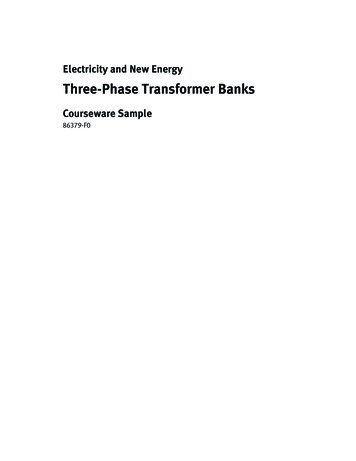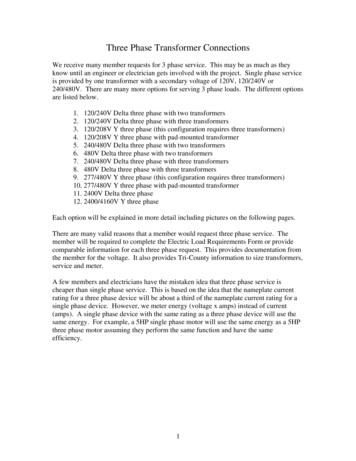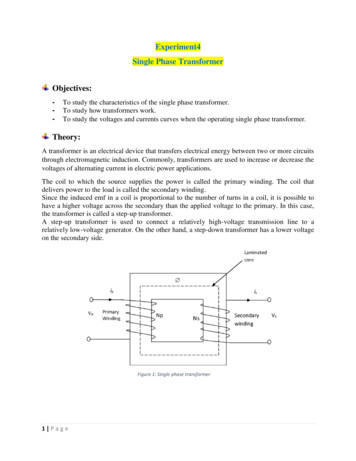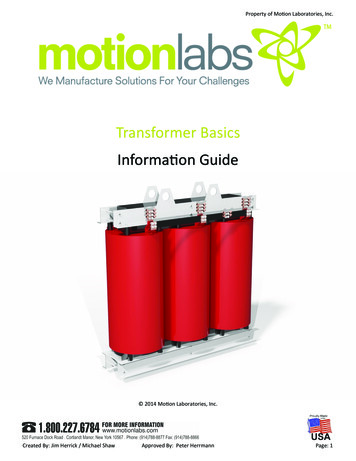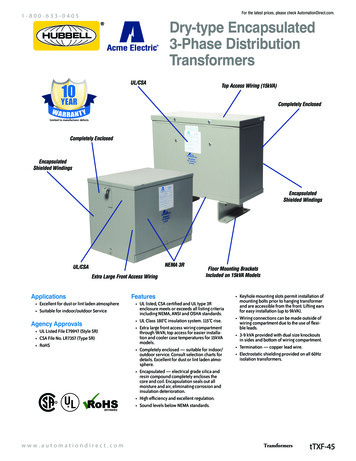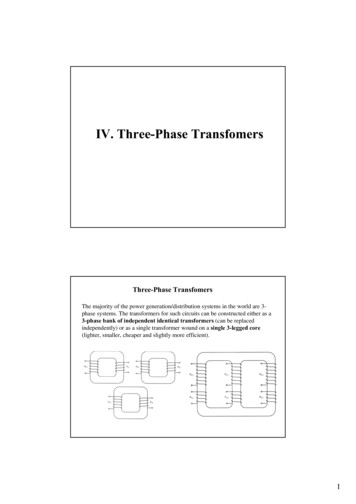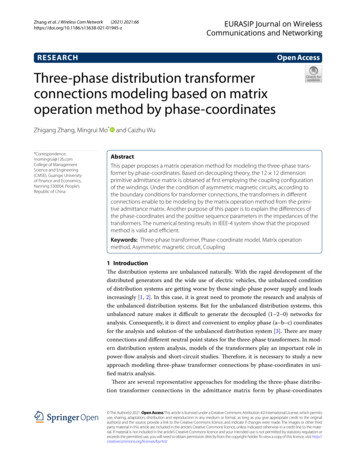
Transcription
(2021) 2021:66Zhang et al. J Wireless Com pen AccessRESEARCHThree‑phase distribution transformerconnections modeling based on matrixoperation method by phase‑coordinatesZhigang Zhang, Mingrui Mo**Correspondence:momingrui@126.comCollege of ManagementScience and Engineering(CMSE), Guangxi Universityof Finance and Economics,Nanning 530004, People’sRepublic of Chinaand Caizhu WuAbstractThis paper proposes a matrix operation method for modeling the three-phase transformer by phase-coordinates. Based on decoupling theory, the 12 12 dimensionprimitive admittance matrix is obtained at first employing the coupling configurationof the windings. Under the condition of asymmetric magnetic circuits, according tothe boundary conditions for transformer connections, the transformers in differentconnections enable to be modeling by the matrix operation method from the primitive admittance matrix. Another purpose of this paper is to explain the differences ofthe phase-coordinates and the positive sequence parameters in the impedances of thetransformers. The numerical testing results in IEEE-4 system show that the proposedmethod is valid and efficient.Keywords: Three-phase transformer, Phase-coordinate model, Matrix operationmethod, Asymmetric magnetic circuit, Coupling1 IntroductionThe distribution systems are unbalanced naturally. With the rapid development of thedistributed generators and the wide use of electric vehicles, the unbalanced conditionof distribution systems are getting worse by those single-phase power supply and loadsincreasingly [1, 2]. In this case, it is great need to promote the research and analysis ofthe unbalanced distribution systems. But for the unbalanced distribution systems, thisunbalanced nature makes it difficult to generate the decoupled (1–2–0) networks foranalysis. Consequently, it is direct and convenient to employ phase (a–b–c) coordinatesfor the analysis and solution of the unbalanced distribution system [3]. There are manyconnections and different neutral point states for the three-phase transformers. In modern distribution system analysis, models of the transformers play an important role inpower-flow analysis and short-circuit studies. Therefore, it is necessary to study a newapproach modeling three-phase transformer connections by phase-coordinates in unified matrix analysis.There are several representative approaches for modeling the three-phase distribution transformer connections in the admittance matrix form by phase-coordinates The Author(s) 2021. Open Access This article is licensed under a Creative Commons Attribution 4.0 International License, which permitsuse, sharing, adaptation, distribution and reproduction in any medium or format, as long as you give appropriate credit to the originalauthor(s) and the source, provide a link to the Creative Commons licence, and indicate if changes were made. The images or other thirdparty material in this article are included in the article’s Creative Commons licence, unless indicated otherwise in a credit line to the material. If material is not included in the article’s Creative Commons licence and your intended use is not permitted by statutory regulation orexceeds the permitted use, you will need to obtain permission directly from the copyright holder. To view a copy of this licence, visit http:// creat iveco mmons. org/ licen ses/ by/4. 0/.
Zhang et al. J Wireless Com Network(2021) 2021:66proposed in [4–10]. Reference [4] developed an approach from the KCL and KVL,which was able to generate the 6 6 matrix in different transformer connectionsaccording to single-phase transformer symmetrical lattice equivalent circuits as theunits grouping up. In the paper, the authors described the transformer in modelrelationship between the phase-coordinates and component coordinates as well.However, the interphase coupling did not be considered in this approach. Later, theimproved models proposed in [5–7] derived from this approach of assembling singlephase transformer equivalent circuits by different connections. Another representative approach generated a primitive matrix by the six coins equivalent circuit of thetransformer in (YN, yn0) connection [8, 9].The main characteristic of this approachwas that the models were obtained from product relations between the primitivematrix and the incidence matrix in different connections, while it was not accuratedescription that the left incidence matrix and the right one were same. Reference [10]accounted for a method of handling matrix singularity in the use of the transformerpower-flow models. And the modified augmented nodal analysis (MANA) [11] wasproposed, which enriched the model application of transformers.There were several flaws in the previous approaches for modeling the three-phasetransformers by phase-coordinates. For one thing, the phase self-impedances andmutual-impedances come from the transformer positive impedances directly, thoughthe phase impedances are much closed to the positive impedances. For another,the most of models described the parameters of 6 coins by 6 6 dimension to 7 7dimension matrix in the models for transformer, only consider the injection currentsat a–b–c phase between the primary and the secondary sides, but not all the currents.In this case, the models did not enable to cover the use of both in power-flow andshort circuit calculations under the asymmetric magnetic circuits.The three-phase AC transmission theory used to be generated from the single-phasemodels of the system equipment by the AC circuit theory based on the symmetricalcharacteristics of the three-phase voltages and currents, which the three-phase symmetry is the characteristic of traditional power system analysis. And the unavoidable asymmetry conditions of the transformers are even more serious than the lines. The purposeof this paper is to model the three-phase transformers in different connections by phasecoordinates by matrix operation method. The main work for studying is show as follows: Generated the primitive admittance matrix from the coupling windings by decoupling method. Modeling the transformers in different connections by matrix operation methodbased on the asymmetric magnetic circuits. Method for obtaining phase-coordinate modified parameters for the models of thetransformers.2 Methods/experimentalThe aim of this paper is to solve the problem for winding connections modeling ofthree-phase transformer by phase-coordinates based on matrix operation method.Page 2 of 23
Zhang et al. J Wireless Com Network(2021) 2021:66Firstly, we introduced the steps to obtain transformer admittance matrix by matrixoperation method. Then we analyzed the modeling for the connections of three-phasedistribution transformer, and also we analyzed the differences of the impedance parameters between phase-coordinates and sequence-coordinates. Finally, we verified the effectiveness of the modeling methods by simulation.3 Modeling methodologyIn this section, the modeling approach for a transformer is described by the matrix operation method from the 12 12 dimension primitive admittance matrix. The complexvariables and the values of parameters are given in per-unit system. Firstly, the couplingconfiguration used prefers to describe and analyze the coupling phenomenon by comparing with the two circuit topologies for a single-phase double-winding transformer.And then the phase-coordinates construction methodology for the three-phase model isdescribed by the following steps. Definition of the transformer primitive admittance matrix YP. Definition of the transformer admittance matrix YT by the matrix operation methodin different connections.Figure 1 shows the main steps of the conceptual scheme of the construction methodology [12]. Firstly, the primitive matrix is generated from the coupling windings shownas the inner blue frame. And then, according to the boundary conditions of the connections at the windings, the transformers are modeled by the matrix operation method.NomenclatureSubscriptsFig. 1 Conceptual scheme of the construction; In red box, the model of the transformer is showed. Besidesthree-phase coins connections in Primary side and secondary side, there are self-inductance and mutualinductance in transformer windings (green box and small black box showed)Page 3 of 23
Zhang et al. J Wireless Com Network(2021) 2021:66Page 4 of 23i or 1 Bus i or Bus 1 (Transformer primary side)j or 2 Bus j or Bus 2 (Transformer secondary side)A, B, C or ABC (ia, ib, ic or iabc) Transformer primary phasesa, b, c or abc (ja, jb, jc or jabc) Transformer secondary phasesVariablesV Voltage complex vector.I Current complex vector.Matrices[Z], Z Impedance matrix, element of impedance matrix.[Y] or Y, y Admittance matrix, element of admittance matrix.3.1 Primitive admittance matrix YPThe two kinds of single-phase equivalent circuits are shown in Fig. 2. Figure 2a is the T-configuration, and Fig. 2b is the coupled configuration. In Fig. 2, “A”, “X” are the two busesat the primary side, “a”, “x” are the two buses at the secondary side respectively. I1, I2 (IA,Ia) are the Injection currents, and V1, V2 (VA, Va) stand for the node voltages at the windings. In Fig. 2a, Z1, Z2 are the windings self-impedances, and jwM is the mutual-impedancebetween windings. w is the angular acceleration. In Fig. 2b, RA, Ra, LA, La are the resistancesand self-inductances at the windings. M is the mutual-inductance. And g0 jb0 is the noload admittance. The circuit relationship in Fig. 2a (in p.u system) can be given byZ1 R1 jw(L1 M)(1)Z2 R2 jw(L2 M)abFig. 2 Single-phase equivalent circuits of the double-winding transformer; a is the model of T-configuration, Z1 and Z 2 are connected together, and The mutual impedance is connected between them. They forma T-shaped connection. b Model of Coupling configuration, which mutual impedance is generated bycoupling
Zhang et al. J Wireless Com Network(2021) 2021:66Page 5 of 23There is potential difference between Bus “X” and “x” in transformer testing experiment. The T-configuration fails to express the electrical characteristics of the transformer, although the calculation enables to equipotential potential. When running insymmetrical operation, the two buses (X, x) are the same at "zero" potential point, sothey can be connected in the form of equipotential. Generally, the two buses are notthe same at the zero potential point when they run in three-phase asymmetric operation. In order to reflect the potential offset phenomenon of neutral point and consider the various connections of transformers, three-phase transformers for modelingshould adopt the form of Fig. 2b.Consequently, there is no electrical connection between Bus X and Bus x in Fig. 2b,which can indicate the potential difference between the two buses. The floating phenomenon without buses grounding and the different connections of the transformerenable to explain as well. While the T-configuration equivalent circuit of transformerin Fig. 2a utilizes the equipotential characteristics at the symmetrical operation,which is not suitable for asymmetrical operation analysis.The application of Fig. 2b at Fig. 1, the three-phase transformer contains 6 coins and12 buses (A–B–C buses and X–Y–Z buses at the primary side; a–b–c buses and x–y–zbuses at the secondary side) shown as Fig. 3, and the generalized primitive model canbe given by a 12 12 matrix using the decoupling methodology. The branch currentequation can be given asIiABCViABC ViXYZ [ZPrim ]6 6(2)IV Vjabcjxyz6 1jabc6 1 ZAA ZAB ZAC ZAa ZAb ZAc ZBA ZBB ZBC ZBa ZBb ZBb Z Z Z Z Z Zwhere [ZPrim ]6 6 CA CB CC Ca Cb Cc , which presents the impedance ZaA ZaB ZaC Zaa Zab Zac Z Z ZbAbBbC Zba Zbb ZbcZcA ZcB ZcC Zca Zcb Zcc 6 6 1.relationship of the transformer, and its admittance is yprim ZprimThe node voltage equation of the transformer can be shown as Fig. 3 A three-phase transformer; It describes the arrangement of 12 coins of a three-phase transformer
Zhang et al. J Wireless Com Network(2021) 2021:66 ViABCIiABC yprim yprim Vjabc Ijabc y V I(3)prim yprimiXYZiXYZ12 12VjxyzIjxyzy yprim YP , which is the full primitive model of the transformerwhere prim yprim yprim12 12 in Y-bus form.3.2 Transformer admittance matrix YTAccording to different connections, we obtain the admittance models based on thematrix operation method from the derivation of the initial admittance matrix YP.Figure 4 is used to describe the (YN, d11) connection of transformer. According topotential relations, we obtainsViX ViY ViZ(4)Vja Vjy , Vjb Vjz , Vjc VjxThe Eq. (4) presents the boundary conditions of the transformer in YN,d11 connection. The admittance matrix can be calculated by the matrix operation methodaccording to the connected relationship of the transformer in YN,d11 connection.Steps to obtain transformer admittance matrix by matrix operation method can beshown as follows:(1) YN connection of primary side: Bus X, Y and Z are grounding, and the rows andcolumns of them are retained in the primitive admittance matrix YP.(2) d11 connection of secondary side:(3) Block 1: Unchanged (the changes of secondary winding connection do not affectthe array of the primary side at YP);(4) Block 2: For the ja column in YT, sum with the elements of the j.jy column,(i.e. j.ja j.ja j.jy ) in YP;Fig. 4 YN, d11 connection of the transformer; In the left side, YN, d11 connection of the transformer isshowed.In the middle, it shows the vector relationship between voltage and terminal in the Y side. And theright side of the figure it shows the vector relationship between voltage and terminal in the D side of thetransformerPage 6 of 23
Zhang et al. J Wireless Com Network(2021) 2021:66Page 7 of 23(5) Block 3: For ja rows in YT, sum with the jy row element jy.j, (i.e. ja.j ja.j jy.j ) inYP;(6) Block 4Non-diagonal elements in YP:a–y: column element: YP * (jb,jy) YTΔ(jb,ja),row element: YP * (jy,jb) YTΔ(ja,jb);b–z: column element: YP * ( jc,jz) YTΔ(jc,jb),row element: YP * (jz,jc) YTΔ(jb,jc);c–x: column element: YP * (ja,jx) YTΔ(ja,jc),row element: YP *(jx,ja) YTΔ(jc,ja);Diagonal elements:(in YT): yja,ja k ja Yja,k (in YP) (Ring network without grounding branch);Preserve three-phase voltage variables, and delete Buses (X, Y, Z, x, y, z) by needed,which can be obtained a 6 6 standard matrix (shown as Fig. 5) to a 7 7 matrix byretention of neutral buses.Based on matrix operation method instead of scanning the branch, the models ofthe transformer are derived from the relationship of the connections, which directlyforms the nodal admittance matrix. The analysis method can be used to three-winding transformers as well.In accordance with the above rules, we can obtain two incidence matrixes (CY andCd11). The Y-bus model relationship (containing neutral voltage variable) of the transformer in YN,d11 connection between (CY,Cd11) and YP can be given byT[YT ]7 7 Cd11 CY YP CYT Cd11(5)whereFig. 5 Blocks of the transformer admittance matrix YT; the blocks of YT are showed. The self-impedance andmutual-impedance are reflected in Block 1 on the primary side. And self-impedance and mutual-impedanceare reflected in Block 4 on the secondary side. Mutual-impedance are reflected in Block 2, 3 on the primaryand secondary side
Zhang et al. J Wireless Com Network (2021) 2021:661Cd11 1 CY Page 8 of 2311111 1 1111 ,10 12 1111111 1 1 1.7 10The model in the Eq. (5) is the complete full transformer admittance model. Generally,we need to retain the related parameters of the three-phase voltage variables. RepeatStep 3, we can enable to obtain a 6 6 matrix.4 Modeling of three‑phase transformersIn this section, the generalized modeling methodology is applied to represent the threephase constructions of transformers. The aim is to demonstrate the matrices of the models in derivation process. All the three-phase two winding transformers are defined inmagnetic circuits of asymmetry configurations in this paper, and symmetric configuration is a special kind of asymmetric configurations.There are the magnetic circuits connecting closely of the transformer in three-phasethree-limb core, besides the magnetic coupling of the primary and secondary windingsof each phase, as well as the magnetic circuits coupling of the different phase windingsas shown Fig. 6. The effects of the coupling of the inter-phase windings are obvious whenthe transformer runs asymmetrically.Considering mutual inductance between the windings, the branch current equationfor conveniently analyzing mutual inductance is IAZAA ZAB ZAC ZAa ZAb ZAcVA VX VB VY ZBA ZBB ZBC ZBa ZBb ZBb IB VC VZ ZCA ZCB ZCC ZCa ZCb ZCc IC V V Z Z Z(6) a aA aB aC Zaa Zab Zac Ia x V V Z Z Z I ZZZybbAbBbCbabbbcb IcZcA ZcB ZcC Zca Zcb ZccVc VzBus X and x, Bus Y and y, Bus Z and z are checked in unequal potentials, and thosebuses do not connect together. The self-impedance of each winding is nearly equal inno-load test, and the relationship of the self-impedance can be given aszAA zBB zCC zaa zbb zcc zs(7)According to the nodal voltage Eqs. (6) and (7), the nodal admittance matrix can beshown by 12 12 dimensions as
Zhang et al. J Wireless Com Network(2021) 2021:66Page 9 of 23Fig. 6 Three-phase two winding transformer in magnetic circuit asymmetry configuration; Three-phase twowinding transformer in magnetic circuit asymmetry configuration shows that there are coupling in windings,as well as the coupling between phasesiAiA ys1iB y& mbaiC y& mca ja ym′jb &&ymba jc &&ymcaiX ys1 iY y& mba iZ y& mcajx ym′ iy &&ymbajz &&ymcaiBy& mabys1y& mcb&&ymabym′&&ymcb y& mab ys1 y& mcb &&ymab ym′ &&ymcbjajbjcy& macym′y& mbc &&ymba&&ymcays1&&ymacys 2&&ymbcy& mba′ymy& mca y& mac ym′ y& mbc &&ymba ys1 &&ymca &&ymac ys 2 &&ymbc y& mba ym′ y& mcaiC&&ymabym′&&ymac&&ymbcym′&&ymcby& mabiXiY ys1 y& mab y& mba ys1 y& mca y& mcb ym′ &&ymab &y&mba ym′y& macys 2y& mbcy& mcbys 2 &&ymca &&ymcbys1y& mab &&ymab &&ymacy s1 ym′ &&ymbc y& mba &&ymcb ym′y& mcay& mcb&&ymabym′ y& mab y& macym′ ys 2 y& mbc &&ymba&&ymcb y& mcb ys 2 &&ymcaiZ y& mac y& mbc ys1 &&ymac &&ymbc ym′y& macy& mbcys1&&ymac&&ymbcym′jx ym′ &&ymba &&ymca ys 2 y& mba y& mcaym′&&ymba&&ymcays 2y& mbay& mcajyjz &&ymab &&ymac ym′ &&ymbc &&ymcb ym′ y& mab y& mac ys 2 y& mbc y& mcb ys 2 &&ymab &&ymac &&ymbc ym′ &&ymcbym′ y& maby& mac ys 2y& mbc y& mcbys 2 (8)where y′m is the mutual admittance between the primary and secondary sides of windings on the same iron-core. ẏm is the mutual admittance among different phases primary(secondary) sides of windings on the different iron-cores. ÿm is the mutual admittanceamong different phases from the primary sides to secondary sides of windings on different iron-cores. ys is the self-admittance on the primary sides or the secondary sides ofwindings.The Bus X, Y, Z and Bus x, y, z of transformer can be connected according to theconnection of transformer to express the corresponding voltages in neutral points,based on the method of Sect. 2.(1) YN,yn0 connectionThe network topology of the transformer in YN,yn0 connection can be shown asFig. 7. And its 6 6 Y-bus matrix can be given by the matrix operation method as
Zhang et al. J Wireless Com Network(2021) 2021:66Page 10 of 23Fig. 7 Topology of the three-phase three-limb core transformer; the three-phase three-limb core transformerhas asymmetric magnetic circuits. The topology shows the relationship between equivalent reactance andconnection of the transformeriA ys1iB y& mbaiC y& mca ja ym′yjb && mbaymcajc &&y& mabys1y& mcb&&ymabym′&&ymcbym′&&ymba&&ymcays 2y& mbay& mcay& macy& mbcys1&&ymac&&ymbcym′&&ymabym′&&ymcby& mabys 2y& mcb&&ymac &&ymbc ym′ &ymac y& mbc ys 2 (9)Ignoring mutual-inductances among the three phases ( ẏ 0, ÿ 0, y′m ym), the6 6 admittance matrix can be given byiAiBiCMjajbjciAiBiC ys 0 0 M ym 0 00ys000ys0ym000ymLLLLMLLLjajbym000ym0ys000ys0jc0 0 ym M 0 0 ys (10)
Zhang et al. J Wireless Com Network(2021) 2021:66Fig. 8 Topology of the transformer by ignoring mutual-inductances; Ignoring mutual-inductances (Whenthe magnetic circuits is balanced), Topology of the transformer is showed like thisFig. 9 YN,d11 Connection of the transformer; YN,d11 Connection of the transformer in the coins is showedlike this. In primary side, Coin X, Y, Z are connected; and (Coin a & z), (Coin b & x) and (Coin c & y) areconnected together in secondary sideThe network topology of the transformer in the Eq. (10) can be shown as Fig. 8.(2) YN,d11 connectionIn Fig. 9, the connected topology of the transformer in YN,d11 connection is presented.For the transformer in the asymmetric magnetic circuits (such as the transformer in threephase three-limb cores), the node admittance matrix is full because of the coupling amongthe windings.The boundary condition is given by the Eq. (4). And the Buses X, Y, Z are grounded. Weenable to obtain the 6 6 Y-bus matrix by the matrix operation method retaining the threephase variables, shown asPage 11 of 23
Zhang et al. J Wireless Com NetworkiA(2021) 2021:66iBys1iA iB y& mbaiC y& mca ymbaja ym′ &&y &&ymcajb && mbaymca ym′jc &&iCy& mabys1y& mcby& macy& mbc&&ymab ym′ym′ &&ymcb&&ymcb &&ymabys1&&ymac &&ymbc&&ymbc ym′ym′ &&ymacPage 12 of 23jajbym′ &&ymab&&ymba ym′&&ymca &&ymcby ja , jay& mba ys 2, jyy& mca ys 2, jx&&ymab &&ymacym′ &&ymbc&&ymcb ym′jcy& mab ys 2, jyy jb, jby& mcb ys 2, jz&&ymac ym′ &&ymbc &&ymba ym′ &&ymca y& mac ys 2, jx y& mac ys 2, jz y jc , jc (11)whereyja,ja y′m ÿmba ÿmab y′m ÿmac ÿmbc ÿmab ys2 ẏmac ys2 2ys2 ÿmac ÿmbc ẏmab ẏmac ;yjb,jb ÿmba ÿmca y′m ÿmcb ÿmbc y′m ẏmba ys2 ẏmbc ys2 2ys2 ÿmba ÿmca ẏmba ẏmbc ;yjc,jc ÿmca y′m ÿmcb ÿmab y′m ÿmac ẏmca ys2 ẏmcb ys2 2ys2 ÿmcb ÿmab ẏmca ẏmcb ;According to different magnetic circuits, the Y-bus model can be given from analyzingthe Eq. (11):(1) Ignoring mutual-inductances among the three phases, the model is able to be seenas the connection by three single-phase transformers assembling. The 6 6 admittance matrix can be given asiAiA ys1iB 0iC 0 ja ym′jb 0 jc ym′iBiCjajbjc0ys10 ym′ym′00ys10 ym′ym′ym′ ym′02 ys 2 ys 2 ys 20ym′ ym′ ym′ 0 ym′ ys 2 ys 2 2 ys 2 0 ys 22 ys 2 ys 2(12)The network topology of the transformer in the Eq. (12) can be shown as Fig. 10.(2) Same iron-core magnetic circuit: y′m ÿm ẏm ym; and the admittance matrixcan be given byia ibia ys1ib ymic ym ja 0jb 0 jc 0ymys1ym000icjaymymys10000002 y s 2 2 ymym y s 2ym y s 2jb000ym y s 22 y s 2 2 ymym y s 2jc0 0 0 ym y s 2 ym y s 2 2 ys 2 2 ym (13)ẏmab ẏmbc 23 y′m , ẏmac 13 y′m,(3) Planemagneticcircuitlayout:1 ′2 ′ÿmab ÿmbc 3 ym , ÿmac 3 ym; the admittance matrix can be given by
Zhang et al. J Wireless Com Network(2021) 2021:66Page 13 of 23Fig. 10 Topology network of the transformer by ignoring mutual-inductances; Topology network of thetransformer by ignoring mutual-inductances is showed in the connection of YN,d11 transformeria ys1 2ia ym′3ib 1 y′ic 3 mja 1 ym′jb 3 jc 1 y ′m 3 2 ym′ 3ibicja2ym′31ym′32ym′31ym′31 ym′31 ym′322 ys 2 ym′32ym′ ys 231ym′ ys 23ys12ym′31 ym′31ym′30ys11 ym′31 ym′32ym′3jb1ym′31ym′31 ym′32ym′ ys 2352 ys 2 ym′32ym′ ys 2 jz3jc2 ym′ 3 0 2ym′ 3 1ym′ ys 2 3 2ym′ ys 2 3 2 ys 2 ym′ (14)(4) Three dimensional split magnetic circuit: ẏmab ẏmbc ẏmac 0.5y′m,ÿmab ÿmbc ÿmac 0.5y′m, and the admittance matrix can be given byiaia ys1ib 0.5 ym′ic 0.5 ym′ ja 0.5 ym′jb 0 jc 0.5 ym′ibic0.5 ym′ys10.5 ym′ 0.5 ym′0.5 ym′0.5 ym′0.5 ym′ys10 0.5 ym′0.5 ym′0ja0.5 ym′ 0.5 ym′02 ys 2 ym′0.5 ym′ ys 20.5 ym′ ys 2jb00.5 ym′ 0.5 ym′0.5 ym′ ys 22 ys 2 ym′0.5 ym′ ys 2jc 0.5 ym′ 0 0.5 ym′ 0.5 ym′ ys 2 0.5 ym′ ys 2 2 ys 2 ym′ (15)5 Method obtaining the admittances by phase‑coordinatesReferences in this paper attempt to convert directly the parameters of symmetry testinto phase-coordinate parameters. In principle, unsymmetrical static three-phaseequipment fails to form decoupled 1–2–0 sequence circuits. As a result, the phasecoordinate parameters converted by the decoupled 1–2–0 parameters are approximate values. Compensation method enables to reduce the errors, but it cannot beequivalent. In order to distinguish between nominal values in this section, variables
Zhang et al. J Wireless Com Network(2021) 2021:66Page 14 of 23and symbols representing per-unit values are marked “*” in the subscript. In this section, the admittance matrix in the Eq. (6) needs to analyze and calculate.5.1 Impedances obtained in the symmetryConsidering the symmetry of structural parameters for three-phase Transformer, therelationship of the Eq. (6) in per-unit system enables to be expressed by VA VX zp ′ VB VY zm ′ VC VZ zm V V z m a x V V z ′′y b m ′′zm Vc Vz ′zm zp ′zm ′′zm zm ′′zm ′zm ′zm zp ′′zm ′′zm zm zm ′′zm ′′zm zs ′′′zm ′′′zm ′′zm zm ′′zm ′′′zm zs ′′′zm ′′ Izm A ′′ I zm B zm IC ′′′ I zm a ′′′zm Ib Ic zs (16)whereZP is the self-admittance on the primary winding;Zs is the self-admittance on the secondary winding;Zm is the mutual-admittance between the primary and the secondary windings atthe same iron-core;′ is the mutual-admittance between the primary windings.Zm ′′ is the mutual-admittance between the primary and the secondary windings atZm the different iron-cores.′′′ is the mutual-admittance between the secondary windings.Zm (1) No-load test: The test enables to obtain the two groups of data, and they are no-loadcurrent I0 and no-load loss P0.The relationships of parameters in no-load state can begiven by y z10 I0 0 0g0 SPTN b0 y2 g 20 (17)0 wherey0* is the no-load admittance; z0* is no-load impedance;g0* is the no-load conductance;b0* is the no-load susceptance;STN is the transformer’s rated capacity.The no-load impedance can be expressed by1(18)g0 jb0 (2) Short circuit test: The test enables to obtain the two groups of data, they are the percentage of short-circuit voltage Vs% and short circuit power loss Pk. The relationshipsof parameters at short-circuit state can be given byz0 r0 jx0
Zhang et al. J Wireless Com Network(2021) 2021:66Page 15 of 23 RT Pk zT Vs xT zT 2 R2(19)T whereRT* is the transformer winding resistance; zT is the leakage reactance; xT* is thewinding reactance. And the impedance in short-circuit state can be given byzT RT jxT (20)The Eqs. (10)–(20) deduced under the condition of the symmetrical currents orvoltages, the above parameters stand for the positive sequence parameters. The stepsfor extrapolating the phase-coordinate parameters can be shown as follows:Considering the same values of leakage reactance on the primary side and secondary side, the relationship (in value system) can be shown byZσ 1 Zσ 2 1(RT jxT )2(21)whereZσ 1,Zσ 2 are the leakage reactances on the primary and secondary sides as Fig. 2bshown. The basic parameters in the symmetry in no load test can be given byZp0 Zs0 12 RT j(xσ 1 x0 )0 jxZm0(22)The reluctances of transformer’s magnetic circuit are mainly from the air gapbetween iron cores. According to the principle of magnetic circuit of phase separation test method, there is the relationship shown as follows: 0zm zAa zBb zCc zm ′0 zm zAB zAC zBA zCA 0.5zm′′zm zAb zAc zBa zBc zCa zCb zaC 0 zaB zaC zbA zbC zcA zcB 0.5zm ′′′0zm zab zac zba zca 0.5zm(23)311xT xσ s xσ m xσ m xσ m xσ m222(24)The leakage fluxes run in the air different from those run in the iron-cores. Thethree-phase symmetrical currents have the effect of magnetization. Similar to threephase transmission lines, they have the basic relationships of positive sequenceimpedance and zero sequence impedance. The relationship between positive sequenceleakage reactance and phase separation leakage reactance of transformer obtainedfrom short circuit test is as follows:wherexσ s is self-inductance leakage flux;xσ m is mutual-inductance leakage flux.
Zhang et al. J Wireless Com Network(2021) 2021:66Page 16 of 23The self-impedance and mutual impedance of the leakage reactance from the shortcurrent test can be given byxσ m xT(25)xσ s 32 xσ m 32 xTBy substituting the Eqs. (14)–(25), the relationship of the impedance matrix by phasecoordinates in YN,yn0 connection can be given by the modified equation in per-unit system shown as VAX V BY VCZ Vax Vby Vcz zp jxσ s z ′ jxσ m m ′ zm jxσ m zm jxσ m ′′ zm jxσ m ′′ jxzm σ m ′ jxzm σ m zp jxσ s ′ jxzm σ m ′′ jxzm σ m zm jxσ m ′′ jxzm σ m ′ jxzm σ m ′ jxzm σ m zp jxσ s ′′ jxzm σ m ′′ jxzm σ m zm jxσ m zm jxσ m ′′ jxzm σ m ′′ jxzm σ m zs jxσ s ′′′ jxzm σ m ′′′ jxzm σ m ′′ jxzm σ m zm jxσ m ′′ jxzm σ m ′′′ jxzm σ m zs jxσ s ′′′ jxzm σ m ′′ jxzm IA σ m ′′ jxzm σ m IB zm jxσ m IC ′′′ jxzm σ m Ia ′′′zm jxσ m Ib zs jxσ s Ic (26)Figure 11 presents the relationships of the vectors in the parametric systems. The relationships for the parameters in References are shown in Fig. 11a. While the relationshipsfor our modified parameters are shown in Fig
phase transformer equivalent circuits by dierent connections. Another representa-tive approach generated a primitive matrix by the six coins equivalent circuit of the transformer in (YN, yn0) connection [, 9].e main characteristic of this approach 8 was that the models w

